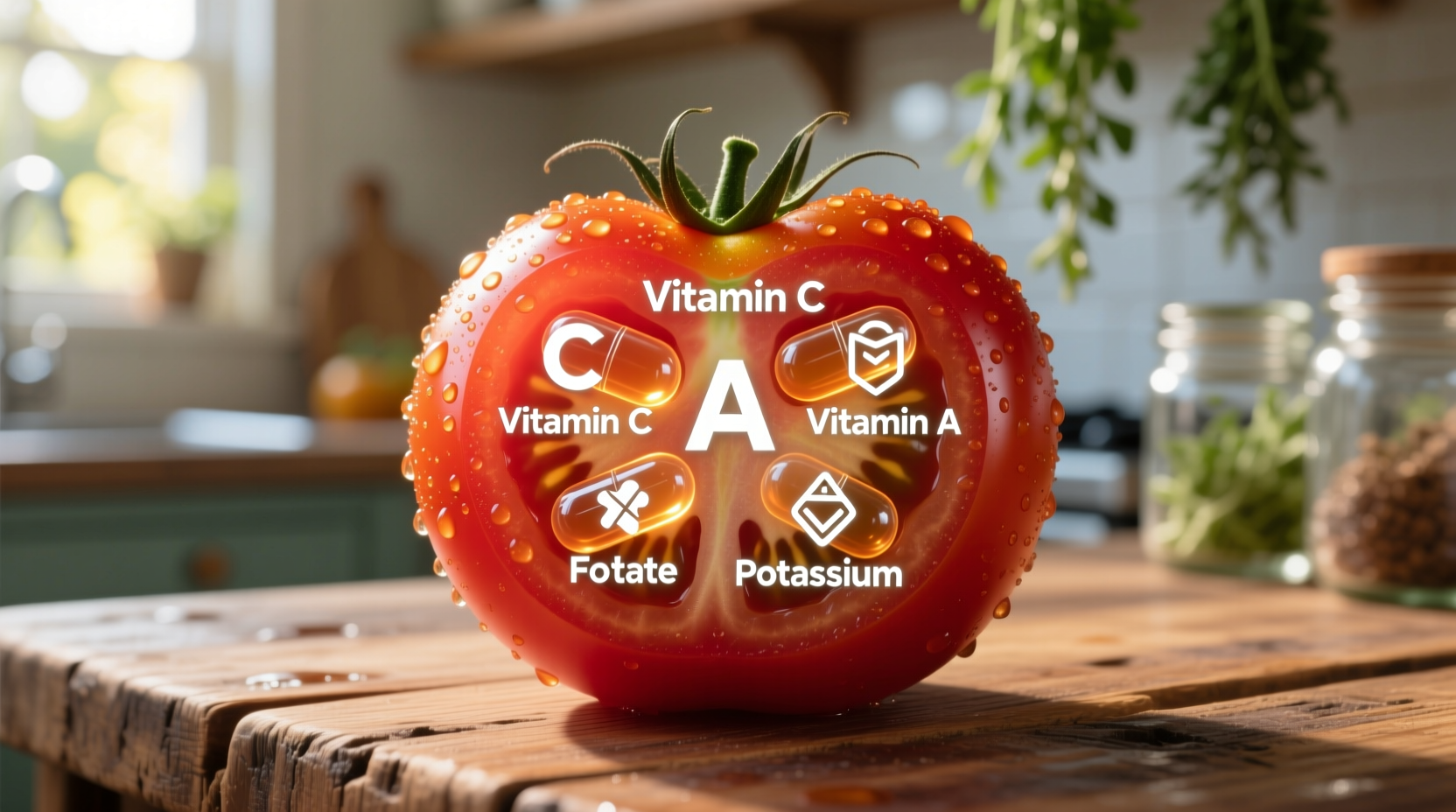Discover exactly which vitamins and nutrients make tomatoes a nutritional powerhouse and how to maximize their health benefits. This science-backed guide reveals the precise vitamin composition of tomatoes, their proven health impacts, and practical strategies to incorporate them effectively into your diet for optimal nutrient absorption.
What Vitamins and Nutrients Actually Exist in Tomatoes
Despite common misconceptions, tomatoes don't contain all vitamins but excel in specific nutrients crucial for human health. According to USDA FoodData Central, a 123g raw medium tomato delivers:
| Nutrient | Amount per Medium Tomato | Daily Value % |
|---|---|---|
| Vitamin C | 17 mg | 28% |
| Vitamin A (as beta-carotene) | 833 IU | 17% |
| Vitamin K | 7.9 mcg | 20% |
| Potassium | 292 mg | 8% |
| Lycopene | 3.1 mg | - |
Unlike citrus fruits, tomatoes provide moderate but consistent vitamin C levels that remain stable through various cooking methods. The vitamin A content comes primarily from beta-carotene, which your body converts as needed. Tomatoes stand out for their exceptional lycopene content—a carotenoid with powerful antioxidant properties not classified as a vitamin but critically important for health.
How Tomato Vitamins Benefit Your Health: Evidence-Based Insights
Research from the National Institutes of Health demonstrates that regular tomato consumption correlates with significant health improvements. The vitamin C in tomatoes supports immune function and collagen synthesis, while the combination of vitamin K and potassium contributes to cardiovascular health.
Lycopene, though not a vitamin, represents tomatoes' most valuable nutrient. A comprehensive review published in Nutrients journal found that lycopene reduces oxidative stress markers by 26% and lowers LDL cholesterol oxidation. Crucially, lycopene absorption increases dramatically when tomatoes are cooked with healthy fats like olive oil.

Tomato Preparation Methods That Maximize Vitamin Absorption
Your cooking technique dramatically affects which tomato vitamins you actually absorb. Harvard T.H. Chan School of Public Health research reveals:
- Raw tomatoes: Best for preserving vitamin C (heat-sensitive)
- Cooked tomatoes: Increases lycopene bioavailability by 35% (source: NIH study)
- Cooked with oil: Boosts lycopene absorption by 2.5x compared to oil-free preparation
- Canned tomatoes: Often contain higher available lycopene than fresh due to processing
For optimal nutrient intake, combine both raw and cooked tomato preparations throughout your week. Add raw tomatoes to salads for vitamin C benefits, while using cooked tomato sauces with olive oil for maximum lycopene absorption.
Tomato Vitamins Compared to Other Common Sources
Understanding how tomatoes stack up against other foods helps you make informed dietary choices. This comparison reveals where tomatoes excel and where other foods might be better vitamin sources:
| Nutrient | Best Source | Tomato Contribution | Practical Takeaway |
|---|---|---|---|
| Vitamin C | Red bell peppers (190mg) | Moderate (17mg) | Combine tomatoes with peppers for synergistic vitamin C boost |
| Vitamin A | Sweet potatoes (21,907 IU) | Moderate (833 IU) | Tomatoes provide usable beta-carotene but aren't primary source |
| Lycopene | Tomatoes (3.1mg) | Exceptional | Tomatoes supply 85% of lycopene in typical Western diets |
| Vitamin K | Kale (547mcg) | Good (7.9mcg) | Tomatoes complement leafy greens for balanced vitamin K intake |
Key Discoveries in Tomato Nutrition Research Timeline
Scientific understanding of tomato nutrients has evolved significantly over the past century. These milestones shaped our current knowledge:
- 1910s: Discovery of tomato's vitamin C content during early nutrition science research
- 1950s: Identification of lycopene as tomatoes' primary carotenoid (source: Journal of Biological Chemistry)
- 1980s: First studies linking tomato consumption to reduced prostate cancer risk
- 1995: Landmark Harvard study establishing lycopene's cardiovascular benefits
- 2002: NIH research demonstrating enhanced lycopene absorption from cooked tomatoes
- 2017: Comprehensive meta-analysis confirming tomatoes' role in reducing oxidative stress markers
Practical Strategies for Maximizing Tomato Vitamin Benefits
Implement these evidence-based approaches to get the most nutritional value from tomatoes:
- Pair with healthy fats: Add olive oil to tomato sauces to increase lycopene absorption by 2.5x
- Choose appropriate preparation: Eat raw tomatoes in salads for vitamin C, cooked for lycopene benefits
- Store properly: Keep tomatoes at room temperature to preserve nutrient integrity (refrigeration reduces flavor compounds)
- Combine strategically: Pair tomatoes with black pepper to enhance antioxidant effects
- Season year-round: Use canned tomatoes in winter to maintain consistent lycopene intake
Remember that variety matters—incorporate different tomato types (cherry, Roma, heirloom) as each offers slightly different nutrient profiles. The USDA recommends at least 1.5 cups of red and orange vegetables weekly, with tomatoes counting toward this goal.











 浙公网安备
33010002000092号
浙公网安备
33010002000092号 浙B2-20120091-4
浙B2-20120091-4